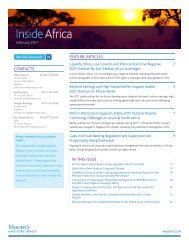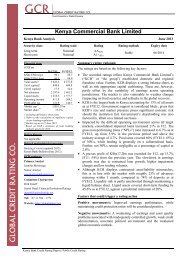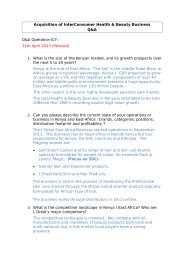NSE-Web-Prospectus-2014
NSE-Web-Prospectus-2014
NSE-Web-Prospectus-2014
You also want an ePaper? Increase the reach of your titles
YUMPU automatically turns print PDFs into web optimized ePapers that Google loves.
Section 6<br />
Development Of Capital Markets<br />
The development of the capital markets in Kenya has a long history<br />
as the <strong>NSE</strong> is in its 60 th year of existence. The following is a selected<br />
brief summary of that development.<br />
1920s – 1953: Dealing in shares commenced with trading taking<br />
place on a ‘gentleman’s agreement’’ with no physical trading floor.<br />
London Stock Exchange (LSE) officials accepted to recognize the<br />
setting up of the Nairobi Stock Exchange as an overseas stock<br />
exchange (1953).<br />
1954 – 1962: The Nairobi Stock Exchange (<strong>NSE</strong>) was registered under<br />
the Societies Act (1954) as a voluntary association of stockbrokers<br />
and charged with the responsibility of developing the securities<br />
market and regulating trading activities. Business was transacted<br />
by telephone and prices determined through negotiation. Securities<br />
traded on the <strong>NSE</strong> during the period mainly included government<br />
debt, loan stocks, preference and common shares.<br />
1963 – 1970: The GOK adopted a new policy with the primary goal<br />
of transferring economic and social control to citizens. By 1968,<br />
the number of listed public sector securities was 66 of which 45%<br />
were for Government of Kenya, 23% Government of Tanzania and<br />
11% Government of Uganda. During this period, the <strong>NSE</strong> operated<br />
as a regional market in East Africa where a number of the listed<br />
public sector securities included issues by the Governments of<br />
Tanzania and Uganda (the East African Community). However, with<br />
the changing political regimes among East African Community<br />
members, various decisions taken affected the free movement of<br />
capital which ultimately led to the delisting of companies domiciled<br />
in Uganda and Tanzania from the Nairobi Stock Exchange.<br />
1971 – 1990: The GOK made a first attempt to directly monitor<br />
the operations of the securities market in an effort to ensure that<br />
capital raised in the market was not used for investment outside<br />
the country. Tight taxation policies were implemented to reduce<br />
repatriation of funds by foreigners and to raise GOK revenue. In<br />
1971, the GOK established the Capital Issue Committee. When<br />
the EAC finally collapsed in 1975, the Government of Uganda<br />
compulsorily nationalized companies which were either quoted or<br />
subsidiaries of listed companies.<br />
1988: The first privatization through the <strong>NSE</strong> took place, through<br />
the successful sale of a 20% GOK stake in Kenya Commercial Bank.<br />
The sale left the Government of Kenya and affiliated institutions<br />
retaining 80% ownership of the bank.<br />
In November 1988, The GOK set up a Capital Market Development<br />
Advisory Council whose role was to work out the modalities for<br />
establishing the Capital Markets Authority (CMA). In November<br />
1989: The Capital Markets Act was passed by Parliament.<br />
In January 1990, The CMA was constituted through the Capital<br />
Markets Authority Act (Cap 495A) and inaugurated in March<br />
1990. The main purpose of setting up the CMA was to have a<br />
body specifically charged with the responsibility of promoting and<br />
facilitating the development of an orderly and efficient capital<br />
market in Kenya.<br />
1991: <strong>NSE</strong> was registered as a private company limited by shares.<br />
Share trading moved from being conducted over a cup of tea, to the<br />
floor based open outcry system.<br />
1993: The CMA increased the initial paid up capital for stockbrokers<br />
from Kshs.100,000 to Kshs.5.0 million while that for investment<br />
advisors was set at Kshs.1.0 million.<br />
1994: With the amendments to the Capital Markets Act, it became<br />
mandatory that a securities exchange approved by the CMA be<br />
a company limited by guarantee. The number of stockbrokers<br />
increased by a further seven.<br />
On February 18, 1994, the <strong>NSE</strong> 20-Share Index reached a record<br />
high of 5,030 points. The <strong>NSE</strong> was rated by the International Finance<br />
Corporation (IFC) as the best performing market in the world with<br />
a return of 179% in dollar terms. The <strong>NSE</strong> also moved to more<br />
spacious premises at the Nation Centre in July 1994, setting up a<br />
computerized delivery and settlement system (DASS).<br />
1995: An additional eight stockbrokers were licensed in June<br />
1995 and with the suspension of one stockbroker, the total<br />
number of stockbrokers was twenty. The CMA established the<br />
Investor Compensation Fund whose purpose was to compensate<br />
investors for financial losses arising from the failure of a licensed<br />
broker or dealer to meet their contractual obligations. To meet its<br />
developmental role, the 1995 amendments to the Capital Markets<br />
Act 995 spelt out regulations providing for foreign investors’<br />
participation in the domestic capital markets.<br />
1996: Privatization of Kenya Airways took place where more<br />
than 110, 000 shareholders acquired a stake in the airline and the<br />
Government of Kenya reduced its stake from 74% to 26%. The<br />
Kenya Airways Privatization team was awarded the World Bank<br />
Award for Excellence for 1996, for being a model success story in<br />
the divestiture of state-owned enterprises.<br />
1997: New rules, regulations and guidelines to govern the issuance<br />
of corporate bonds and commercial paper were issued by the CMA.<br />
With the objective of developing a code of conduct, promoting<br />
professionalism, and establishing examinable courses for its<br />
members as well as facilitate liaison with the CMA and the <strong>NSE</strong>,<br />
the members of the <strong>NSE</strong> formed the Association of Kenya Stock<br />
brokers (AKS).<br />
1998: The CMA published new guidelines on the disclosure<br />
standards by listed companies. The disclosure requirements were<br />
meant for both public offerings of securities as well as continued<br />
reporting obligations, among others. On July 17, 1998, Mr. Robert<br />
E. Rubin, the 70th United States Secretary to the Treasury, visited<br />
the trading floor of the Nairobi Stock Exchange.<br />
29






